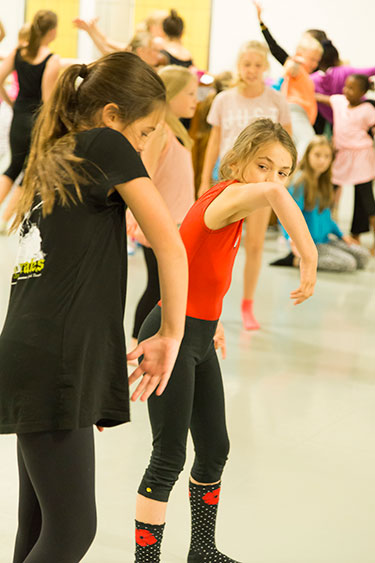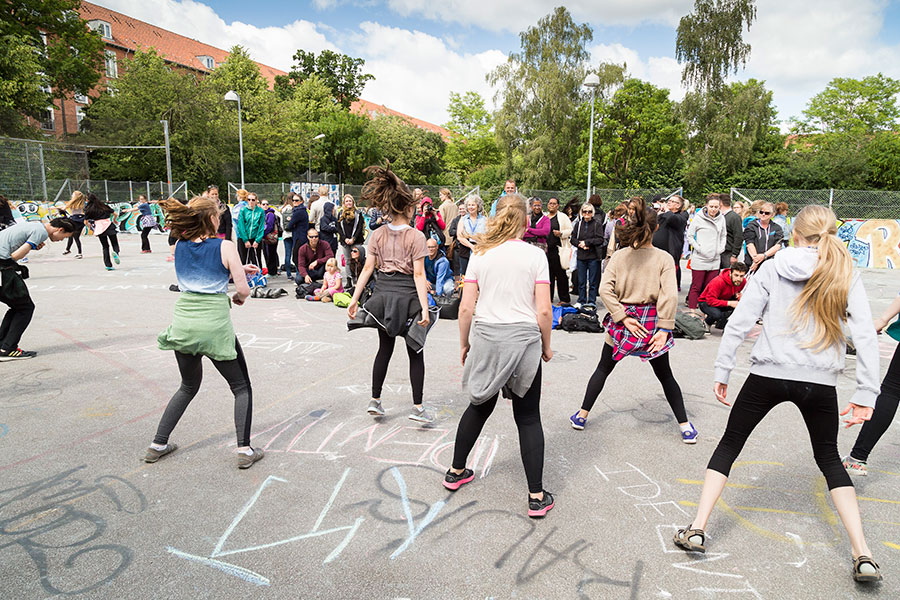

In July 2012 Copenhagen was announced as the host for the 13th Dance and the Child International Congress. Dansehallerne, as the national competence centre for contemporary dance; The Department of Nutrition, Exercise and Sports–NEXS, University of Copenhagen and the Dance Partnership Education, The Danish National School of Performing Arts, took up the challenge and collaborated on the planning of the event. Three years on we were able to welcome over 800 international participants from 22 different countries, to Tivoli Gardens, who sponsored the opening event, to Copenhagen.
Dansehallerne and The University of Copenhagen, NEXS, physically hosted the many workshops, Dance Flavours, Creative Meeting Points, Youth Forums, Keynote speeches, lectures, panel discussions and performances with the theme of ‘Twist and Twin’–Exploring Identities in Dance. The idea of ‘twinning’ was encompassed and expressed in a multitude of methods and ways–culturally, pedagogically, across age groups and between professions, institutions and communities. Some twinning started before the Congress with virtual ‘Twin Labs’; during the Congress in the form of collaborative workshops and meetings between researchers, professionals and practitioners, and we hope, after the congress with partnerships and friendships initiated during the twinning process, continuing to flourish.
Exploring identities in dance
Exploring identities in dance was the overall theme for the work presented by researchers, teachers and the many Young People’s Performances. Over 500 young people and children registered for the congress with 35 groups from 15 different countries presenting their choreographic works during the weeklong congress and offering performances of high quality. Researchers and workshop holders had topics ranging from gender issues to empowerment and wellbeing, from assessment and evaluation to embodiment and learning.
During the five days the participants could enjoy taking Dance Flavours, a selection of warm-up classes in the mornings, ranging from Yoga and Gaga to House and Waacking, followed by their own rehearsals or Creative Meeting Points in the mornings. In the afternoons the participants had the possibility of taking two workshops from the over 90 possibilities that were offered. In the evenings, performances by the young people themselves or professional performances from Denmark were offered and enjoyed by all.
Keynote presentations
The opening keynote speech Moving Together: Dance in a Shared World was given by Francois Matarasso, freelance artist and Honorary Professor at Robert Gordon University, Aberdeen, Scotland. In his speech he discussed the concept of twinning as a framework for artistic exploration and mutual understanding in a globalized world. Following the keynote a panel of speakers shared their experiences and contributed to deepen central aspects of twinning from various perspectives.
On the following day, under the sub-theme of Assessment, research and evaluation tools, Susanne Keuchel, Professor, Dr., Director of Remscheid Academy for Arts Education, Germany and Michael Wimmer, Dr., Head of Educult, Institute for Cultural Policy and Management, Vienna, Austria, held a keynote speech entitled The Art of Stepping Aside–Chances, Potentials and Deficits in Arts Education Research. Following the keynote there were roundtable discussions for participants to consider and discuss what could be significant new directions for researchers in dance education and potentially how each could influence this change.
The first of the final keynote speeches under the sub-theme of Embodiment, learning and education, was presented by Mark Schram Christensen, Associate Professor, Dr., Department of Neuroscience and Pharmacology, University of Copenhagen, and Kirstie Simson, Associate Professor, Department of Dance, University of Illinois. Entitled What Moves Us and Why? A Neurophysiological Investigation of Movement Perception Twinned with a Thirty-Five Year Exploration of Dance Improvisation, the two presenters complemented each others contributions form their respective areas of expertise. With words from Mark Scram Christensen, Kirstie Simson, offered physical input enhancing and offering an insight into her beliefs that dance improvisation can be a powerful source of embodied intelligence that can heal and empower individuals. The final keynote under the sub-heading, Empowerment, well-being and policy making, was presented by Ralph Buck, Associate Professor, University of Auckland, New Zealand and Erica Rose Jeffrey, MA in peace and conflict studies, University of Queensland, Australia, and PhD candidate. Their presentation was entitled Empowering Dance in Our Communities: Making the Connection Visible. Through profiling their own experiences in policymaking and well-being, the speakers made a call for the bold empowerment of dance in our communities across ages, disciplines and organizations.
The ‘Copenhagen Declaration’
As part of this strategy for heightening the profile of dance, Ralph Buck and Erica Rose Jeffrey presented the ‘Copenhagen Declaration’. During the preceding week Ralph Buck and Erica Rose Jeffrey had been in dialogue with children, young people, researchers and teachers regarding the formulation and content of this important document. The document outlines how the artistic subject areas, including dance can contribute to education, in its broadest sense, in terms of sustainable development and contributing to a sense of global community. The document was then presented to Jens Dalgaard, general secretary for the Danish UNESCO national commission. He, in turn, will bring this document further in UNESCO’s organisation to enlist their support in promoting the on-going international work to strengthen children and young peoples meeting and involvement with the arts during their education. The declaration is a prime example of how research and practice can enrich and inspire each other in relation to developing new knowledge and future political strategies, where this new knowledge can then be implemented in practice.

Creative Meeting Point–daCi 2015
Photo: Jens Hemmel
The broad spectrum of topics and depth of knowledge presented by the international speakers provided the participants with an insight into the many ‘twinnings’ that dance can have and the far-reaching consequences that these collaborations can initiate.
New initiatives– SpringBoarders
A new initiative for this daCi Congress was the establishment of the daCi SpringBoard which was initiated to involve recently qualified dance graduates, teachers and professionals who have a particular interest in working with young people. The SpringBoard is designed to bridge the gap between the young people who participate in the congress and the daCi members who participate as presenters and facilitators. Applicants for this new initiative were invited to apply from the host country and other member countries and the successful candidates were then funded to attend the daCi Congress. 10 candidates were chosen, 5 from the host country Denmark and five from other countries. The SpringBoarders were responsible for facilitating the Youth Forums, setting topics of common interest and initiating discussions in groups for the young people participating. The SpringBoarders also designed ‘Pop-up Meeting Points’ so that the young participants could also take part in informal gatherings and events that were most pertinent to their age group. The SpringBoarders will continue to be in contact and eventually have responsibility for mentoring the next generation of SpringBoarders for the 2018 Congress.
Another new initiative for the Congress was to create a ¨twinning space¨ to facilitate the possibility for longer standing dance friendships between the participants. With a relatively short congress it is a challenge to create the basis for expanded and sustainable dance exchanges between the young dancers. As the host we created a virtual meeting space for the participants on the website. Here they could meet virtually, many months before the congress, in what we called the «twinning space» to exchange dance ideas and maybe find a partner for a twinning project. During the congress 3 of the twinning projects were offered studio space every day to continue to work and develop their joint project. Their process and product were shared with other participants at the end of the week. We hope the experiences from the twinning projects in Copenhagen will survive and be further developed through to the next congress in Australia.
The vibrant closing event took place outside Dansehallerne where the ‘torch’ for the next international Congress was given over to Adelaide, Australia, where the University of South Australia will be hosting the event in 2018. You can become a daCi member and follow the planning on http://www.daCi.org. Come and join us at this fantastic event!
Sheila de Val.

Site specific showing - daCi 2015
Photo: Jens Hemmel